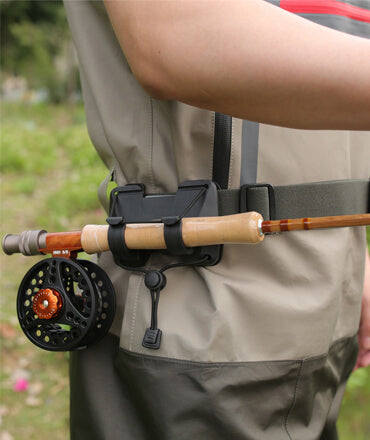Fly Line: Understanding Fly Fishing Leader Line Length, Weight, and Knots
When it comes to fly fishing, the line I choose plays a crucial role in my success on the water. Understanding the types of fly fishing line, including floating and sinking options, is essential for matching my technique to the conditions I face. Additionally, selecting the right leader line length and weight is vital for ensuring my presentation is effective and natural.

I often find that the leader line serves as the critical link between my fly and the fish. The appropriate leader line length can vary based on the species I'm targeting and the water conditions. Weighing these factors helps me determine the best setup for various situations.
Choosing the right knots for attaching my tippet ensures that I'm ready for any challenges I might encounter during a day on the water. Mastering these techniques not only enhances my confidence but also improves my overall effectiveness as an angler.
Fly Line Essentials

In fly fishing, understanding the essentials of fly lines is crucial for optimal performance on the water. Key aspects include the types of fly lines, their characteristics, and how to connect them effectively.
Types of Fly Lines
I primarily use three types of fly lines: floating, sinking, and intermediate. Floating lines are ideal for surface presentations, allowing dry flies to maintain their intended action. Sinking lines are designed to allow flies to reach deeper water levels quickly. They come in various sink rates, such as fast or slow, to accommodate different fishing conditions. Intermediate lines provide a compromise, sinking slowly to target the water column.
Each type of line has specific weights and diameters, impacting casting and retrieval. For instance, the line weight should match the rod and reel rating for efficient performance. This ensures that my setup works harmoniously, ultimately enhancing my casting experience.
Fly Line Characteristics
Fly line characteristics are crucial for effective angling. The taper refers to the gradual change in thickness along the line. A weighted front taper enhances casting distance and accuracy, particularly important with larger flies or windy conditions. By contrast, a double taper line offers versatility, providing a balanced performance for various casting styles.
The line diameter influences casting distance and drag. Thinner lines cut through the wind, while thicker lines provide better buoyancy with floating techniques. Additionally, I pay attention to line density; for example, shooting heads are thinner, designed for distance casting.
Fly Line Connections
Connecting various elements of my fly fishing setup is vital. I favor the loop-to-loop connection, which allows for quick line changes and easy adjustments. This technique permits seamless transitions between different lines without compromising strength.
Another reliable method is the nail knot, ideal for joining my fly line to the backing or leader. This knot is streamlined and maintains a low profile. Lastly, the blood knot is my go-to for attaching tippets to leaders, providing optimal strength for heavy catches.
Incorporating these connections ensures that my setup is reliable and ready for any fishing situation.
Leader Design and Functionality

In fly fishing, the design and functionality of the leader are critical for effective presentations. The leader length, material, and construction influence how the fly behaves in the water, ensuring a successful catch.
Leader Length Variations
Leader lengths typically range from 7.5 to 12 feet. I often use a 9-foot leader for general applications, balancing reach and control. For small streams, shorter leaders can provide better accuracy, while longer leaders are beneficial for delicate presentations with dry flies or nymphs.
Adjusting the tippet length is also key, as a shorter tippet reduces drag. I prefer using tippet sizes varying from 5X to 7X for lighter flies and larger fish. Ensuring the right leader length can enhance the stealth and presentation of the fly.
Leader Material Properties
The choice of leader material affects its performance. I gravitate towards monofilament for its versatility and ease of use. It offers good knot strength and flexibility but can be highly visible in clear water.
Fluorocarbon leaders are my preference when fishing in clear conditions due to their low visibility and sink rate. These leaders provide better sensitivity and abrasion resistance. The right material will influence both the casting performance and the fish's likelihood of biting.
Optimizing Leader for Fly Fishing Techniques
Optimizing the leader for specific techniques is essential. When using dry flies, I opt for a tapered leader to allow for smooth turnover in the cast. This prevents the fly from landing too harshly on the water’s surface.
For wet flies and streamers, I often use a straight leader or one with minimal taper to ensure a more direct presentation. The correct blend of leader taper and length adapts well to various fishing scenarios. Adjusting these elements plays a significant role in my fly fishing success.
Advanced Knots and Rigging
In fly fishing, mastering advanced knots and rigging techniques enhances precision and effectiveness. I will cover essential knots and how to create custom leaders to tackle different fishing situations.
Essential Knots for Fly Fishing
Using the right knots is crucial for secure connections between your fly line, leader, and tippet material. Here are some top choices:
-
Double Uni Knot: An effective knot for joining two lines. I prefer it for attaching tippets made of fluorocarbon to my nylon leaders. Its strength and ease of tying make it dependable in various conditions.
-
Perfection Loop: This knot creates a loop at the end of the line. I use it to attach flies to my tippet. It enables easy fly changes, which is vital when targeting different species.
-
Surgeon's Knot: This knot is ideal for joining two pieces of line with different diameters. I find it useful for connecting my tippet with a thicker leader. Its simplicity and reliability in maintaining breaking strain make it a favorite.
Custom Leaders for Targeted Fishing
Custom leaders can significantly improve my success in various fly fishing scenarios. Understanding leader formulas helps me create effective setups based on my target species.
For nymph fishing, I choose a shorter, heavier leader with 3X or 4X tippet material. This setup helps sink the nymph quickly.
For dry fly fishing, a longer, lighter tapered leader works best. I typically use 4X to 6X tippet, which allows for delicacy and avoids spooking the fish.
I often adjust my leader length and weight based on the fly size I am using. Utilizing fluorocarbon leaders enhances invisibility underwater, which can give me an edge in clear water conditions.
Tactical Considerations
When preparing for a fly fishing outing, selecting the right line and leader is crucial. The choices I make can significantly impact my success based on the species I aim to catch and the conditions I face.
Selecting Line and Leader for Fish Species
Choosing the correct line and leader depends largely on the target species. For trout fishing, I typically opt for lighter lines, usually ranging from 2 to 6-weight, to ensure a delicate presentation. In contrast, for species like striped bass, I prefer a heavier line of 8-10 weight to withstand their strength.
The leader length also matters. A longer leader can help with stealth in clear waters, while a shorter leader works well in windy conditions or for casting heavier flies. Engaging in a conversion table for line weights and breaking strengths helps me match my line choices accurately.
Matching Tippet to Fly and Conditions
Selecting the right tippet is essential for both fly presentation and the fish's ability to take the fly. I choose tippet material based on the water clarity and the size of the fly. For clearer waters, thinner tippet diameters (e.g., 5x or 6x) provide a more natural presentation.
The tippet's breaking strength should align with the rod weight and fish size. For smaller fish like trout, I use tippett with a breaking strength of 4-5 lbs. For larger species such as bass, I opt for heavier tippets, potentially exceeding 10 lbs, to withstand their fight.











